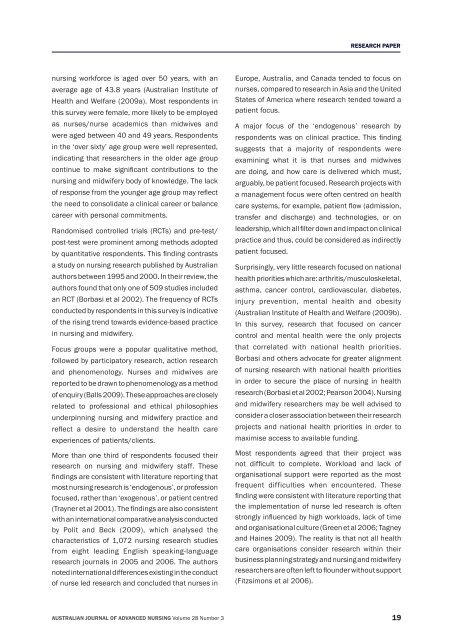australian journal of advanced nursing
australian journal of advanced nursing
australian journal of advanced nursing
You also want an ePaper? Increase the reach of your titles
YUMPU automatically turns print PDFs into web optimized ePapers that Google loves.
<strong>nursing</strong> workforce is aged over 50 years, with an<br />
average age <strong>of</strong> 43.8 years (Australian Institute <strong>of</strong><br />
Health and Welfare (2009a). Most respondents in<br />
this survey were female, more likely to be employed<br />
as nurses/nurse academics than midwives and<br />
were aged between 40 and 49 years. Respondents<br />
in the ‘over sixty’ age group were well represented,<br />
indicating that researchers in the older age group<br />
continue to make significant contributions to the<br />
<strong>nursing</strong> and midwifery body <strong>of</strong> knowledge. The lack<br />
<strong>of</strong> response from the younger age group may reflect<br />
the need to consolidate a clinical career or balance<br />
career with personal commitments.<br />
Randomised controlled trials (RCTs) and pre‑test/<br />
post‑test were prominent among methods adopted<br />
by quantitative respondents. This finding contrasts<br />
a study on <strong>nursing</strong> research published by Australian<br />
authors between 1995 and 2000. In their review, the<br />
authors found that only one <strong>of</strong> 509 studies included<br />
an RCT (Borbasi et al 2002). The frequency <strong>of</strong> RCTs<br />
conducted by respondents in this survey is indicative<br />
<strong>of</strong> the rising trend towards evidence‑based practice<br />
in <strong>nursing</strong> and midwifery.<br />
Focus groups were a popular qualitative method,<br />
followed by participatory research, action research<br />
and phenomenology. Nurses and midwives are<br />
reported to be drawn to phenomenology as a method<br />
<strong>of</strong> enquiry (Balls 2009). These approaches are closely<br />
related to pr<strong>of</strong>essional and ethical philosophies<br />
underpinning <strong>nursing</strong> and midwifery practice and<br />
reflect a desire to understand the health care<br />
experiences <strong>of</strong> patients/clients.<br />
More than one third <strong>of</strong> respondents focused their<br />
research on <strong>nursing</strong> and midwifery staff. These<br />
findings are consistent with literature reporting that<br />
most <strong>nursing</strong> research is ‘endogenous’, or pr<strong>of</strong>ession<br />
focused, rather than ‘exogenous’, or patient centred<br />
(Trayner et al 2001). The findings are also consistent<br />
with an international comparative analysis conducted<br />
by Polit and Beck (2009), which analysed the<br />
characteristics <strong>of</strong> 1,072 <strong>nursing</strong> research studies<br />
from eight leading English speaking‑language<br />
research <strong>journal</strong>s in 2005 and 2006. The authors<br />
noted international differences existing in the conduct<br />
<strong>of</strong> nurse led research and concluded that nurses in<br />
RESEARCH PAPER<br />
Europe, Australia, and Canada tended to focus on<br />
nurses, compared to research in Asia and the United<br />
States <strong>of</strong> America where research tended toward a<br />
patient focus.<br />
A major focus <strong>of</strong> the ‘endogenous’ research by<br />
respondents was on clinical practice. This finding<br />
suggests that a majority <strong>of</strong> respondents were<br />
examining what it is that nurses and midwives<br />
are doing, and how care is delivered which must,<br />
arguably, be patient focused. Research projects with<br />
a management focus were <strong>of</strong>ten centred on health<br />
care systems, for example, patient flow (admission,<br />
transfer and discharge) and technologies, or on<br />
leadership, which all filter down and impact on clinical<br />
practice and thus, could be considered as indirectly<br />
patient focused.<br />
Surprisingly, very little research focused on national<br />
health priorities which are: arthritis/musculoskeletal,<br />
asthma, cancer control, cardiovascular, diabetes,<br />
injury prevention, mental health and obesity<br />
(Australian Institute <strong>of</strong> Health and Welfare (2009b).<br />
In this survey, research that focused on cancer<br />
control and mental health were the only projects<br />
that correlated with national health priorities.<br />
Borbasi and others advocate for greater alignment<br />
<strong>of</strong> <strong>nursing</strong> research with national health priorities<br />
in order to secure the place <strong>of</strong> <strong>nursing</strong> in health<br />
research (Borbasi et al 2002; Pearson 2004). Nursing<br />
and midwifery researchers may be well advised to<br />
consider a closer association between their research<br />
projects and national health priorities in order to<br />
maximise access to available funding.<br />
Most respondents agreed that their project was<br />
not difficult to complete. Workload and lack <strong>of</strong><br />
organisational support were reported as the most<br />
frequent difficulties when encountered. These<br />
finding were consistent with literature reporting that<br />
the implementation <strong>of</strong> nurse led research is <strong>of</strong>ten<br />
strongly influenced by high workloads, lack <strong>of</strong> time<br />
and organisational culture (Green et al 2006; Tagney<br />
and Haines 2009). The reality is that not all health<br />
care organisations consider research within their<br />
business planning strategy and <strong>nursing</strong> and midwifery<br />
researchers are <strong>of</strong>ten left to flounder without support<br />
(Fitzsimons et al 2006).<br />
AUSTRALIAN JOURNAL OF ADVANCED NURSING Volume 28 Number 3 19

















